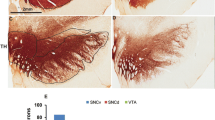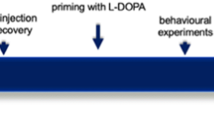Abstract
1-methyl-4-phenyl-1,2,5,6-tetrahydropyridine (MPTP) has been shown to produce a parkinsonian syndrome in humans and other primates. Recent studies have demonstrated that in humans the hypothalamus has the highest binding density for (3H) MPTP, which corresponds to monoamine oxidase type B (MAO-B). There is evidence that the conversion of MPTP to the toxic compound MPP+ takes place in the hypothalamus; subsequently, MPP+ is transported to the striatal system, where destruction of nigrostriatal dopamine neurons occurs. Thus, the hypothalamus appears to be a primary target organ of MPTP toxicity. This assumption is supported by the observation that monkeys exposed to MPTP exhibit extensive pathological lesions in the hypothalamus which are manifested clinically by the development of life-threatening anorexia requiring forced feeding to overcome. We discuss the clinical implications of MPTP-induced hypothalamic damage to the pathophysiology of MPTP-induced parkinsonism and to Parkinson disease. It is suggested that consideration of hypothalamic involvement in MPTP-induced parkinsonism may provide a broader understanding of the pathophysiology of parkinsonism and may, in addition, account for the preliminary observations that MAO-B inhibitors retard the progression of Parkinson disease and possibly prolong life expectancy.
Sommario
La l-metil-4-fenil-1,2,5,6 tetraidropiridina (MPTP) produce una sindrome parkinsoniana nell'uomo e in alcuni primati; studi recenti hanno dimostrato che nell'uomo l'ipotalamo ha la più alta capacità di legare il (3H) MPTP. È dimostrato che la conversione dell'MPTP nel composto tossico MPP+ si svolge nell'ipotalamo; successivamente lo MPP+ è trasportato al sistema striato e quindi si determina una distribuzione dei neuroni della dopamina nigrostriatale. Risulta così che l'ipotalamo è l'organo bersaglio primario della tossicità dell'MPTP e ciò è dimostrato dalla osservazione che le scimmie esposte al-l'azione dell'MPTP presentano estese lesioni patologiche nell'ipotalamo e manifestano clinicamente una anoressia di tale gravità da richiedere l'alimentazione forzata. Noi discutiamo le implicazioni cliniche del danno ipotalamico da MPTP con la patofisiologia del parkinsonismo indotto da MPTP e col morbo di Parkinson. Riteniamo che l'interessamento ipotalamico nel Parkinson indotto da MPTP può dare una più ampia interpretazione della fisiopatofisiologia del parkinsonismo e può dare spiegazione di osservazioni preliminari che dimostrano che i MAO-B inibitori ritardano la progressione del morbo di Parkinson e prolungano probabilmente l'aspettativa di vita.
Similar content being viewed by others
References
Birkmayer W., Knoll J., Riederer P., et al.:Increased life expectancy resulting from addition of L-deprenyl to Madopar treatment in Parkinson's diseases: A longterm study. J. Neural Transm, 64:113–127, 1985.
Butterworth R.F., Belanger F., Barbeau A.:Hypokinesia is produced by anterolateral hypothalamic 6-hydroxydopamine lesions and its reversal by some antiparkinson drugs. Pharmacol Biochem Behav, 8:41–45, 1977.
Chiba K., Trevor A., Castagnoli N.:Metabolism of the neurotoxic amine, MPTP, by brain monoamine oxidase. Biochem Biophys Res Comm, 120:574–578, 1984.
Costall B., Taylor R.J.:The role of telencephalic dopaminergic systems in the mediation of apomorphine-stereotypes behavior. Eur J Pharmacol, 24:8–24, 1973.
Davis G.C., Williams A.C., Markey S.P., et al.:Chronic parkinsonism secondary to intravenous injection of meperidine analogues. Phychiatry Res., 1:249–254, 1979.
Eisler T., Thorner M.O., MacLeod R.M., et al.:Prolactin secretion in Parkinson disease. (3H) Neurology, 31:1356–1359, 1981.
Enz A., Hefti F., Frick W.:Acute administration of 1-methyl-4-phenyl-1,2,3,6-tetrahydropyridine (MPTP) reduces dopamine and serotonin but acceletates norepinephrine metabolism in the rat brain: effect of chronic pretreatment with MPTP. Eur J Pharmacol, 101:37–44, 1984.
Forno L.S.:Pathology of parkinsonism: a preliminary reports of 24 cases. J Neurosurg, 24 (suppl): 266–271, 1966.
Forno L.S., Langston J.W., DeLanney L.E., et al.:Locus coeruleus lesions and eosinophilic inclusions in MPTP-treated monkeys, Ann Neurol. 20:449–455, 1986.
Fuller R.W., Hahn R.A., Snoddy H.D.:Depletion of cardiac norepinephrine in rats and mice 1-methyl-4-phenyl-1,2,3,6-tetrahydropyridine (MPTP) Biochem. Pharmacol. 33:2957–2960, 1984
Gibb W.R.G., Lees A.J., Jenner P., Marsden C.D.:The dopamine neurotoxin N-methyl-4-phenyl-1,2,3,6-tetrahydropyridine (MPTP) produces histological lesions in the hypothalamus of the common marmoset. Neurosci Letters, 65:79–83, 1986.
Halliwell B.:Manganese ions, oxidation reactions and the super-oxide radical. Neurotoxicology (Park Forest. II.) 5:113–118, 1984.
Heikkila R.E., Mazino L., Cabat F.S., et al.:Protection against the dopaminergic neurotoxicity of 1-methyl-4-phenyl-1,2,5,6-tetrahydropyridine by monoamine oxidase inhibitors. Nature. 311:467–469, 1984.
Hirano M., Uchimura H., Salto M.:Regional distribution of monoamine oxidase activity for 5-hydroxytryptamine and tyramine in hypothalamus of the rat. Brain Res, 93:558–563, 1975.
Hirano A., Zimmerman H.M.:Alzheimer's neurofibrillary changes: a topographic study, Arch Neurol. 7:227–243, 1962.
Irwin I., Langston J.W.:Selective accumulation of MPP+ in the substantia nigra: A key to neurotoxicity? Life Sci, 6:207–212, 1985.
Javitch J.A., Uhl G.R., Sydney S.H.:Parkinsonism-inducing neurotoxin, N-methyl-4-phenyl-1,2,3,6-tetrahydropyridine: characterisation and localization of receptor binding sites in rat and human brain. Proc Natl Acad Sci U.S.A., 81:4591–4595, 1984.
Javitch, J.A., Snyder S.H.:Uptake of MPP+ by dopamine neurons explains selectivity of parkinsonism-inducing neurotoxin, MPTP, Eur Pharmacol, 106:455–456, 1984.
Javitch J.A., D'Amato R.J., Strittmatter S.M., et al.:Parkinsonian inducing neurotoxic MPTP-uptake of the metabolite N-methyl-4-phenyl-tyramine by dopamine neurons explains behavioral toxicity. Proc Natl Acad. Sci USA, 82:2173–2177, 1985.
Javoy-Agid F., Ruberg M., Pique L. et al.:Biochemistry of the hypothalamus in Parkinson's disease. Neurology, 34:672–675, 1984.
Knoll J., Dallo J., Yen TT.:Striatal dopamine. sexual activity and lifespan. Longevity of rats treated with (-) deprenyl. Life Sci, 45:525–531, 1989.
Langston J.W., Forno L.S.:The hypothalamus in Parkinson disease. Ann Neurol 3:129–133, 1978.
Langston J.W., Ballard P., Tetrud J.W., Irwin I.:Chronic parkinsonism in humans due to a product of meperidine-analog synthesis, Science, 219:979–980, 1983.
Langston J.W., Irwin I., Langston E.B., et al.:Pargyline prevents MPTP-induced parkinsonism in primates. Science, 225: 1480–1482, 1984.
Leibowitz S.F., Weiss G.F., Shor-Posner G.:Hypothalamic serotonin: Pharmacological, biochemical, and behavioral analyses of its feeding-suppressive action. Clin Neuropharmacol., 11 (suppl 1): S51-S71, 1988.
Lewy F.H.:Die Lehre vom Tonus und der Bewegung. Berlin: Springer, 1923.
Lipman I.J., Boykin M.E., Flora R.E.:Glucose intolerance in Parkinson's disease. J. Chronic Dis, 27:573–579, 1974.
Martignoni E., Micieli G., Cavallini A. et al.:Autonomic disorders in idiopathic parkinsonism. J Neural Transm, 22 (suppl): 149–161, 1986.
Nisbett R.E., Braver A., Jusela G. et al.:Age and sex differences in behaviors mediated by the ventromedial hypothalamus. J. Comp Physiol Psychol, 88:735–746, 1975.
Ohama E., Ikuta F.:Parkinson's disease: distribution of Lewy bodies and monoamine neuron system. Acta Neuropathol, 34:311–319, 1976.
Orskov L., Jakobsen J., Dupont E., et al. Autonomic function in parkinsonian patients relates to duration of disease. Neurology, 37:1173–1178, 1987.
Piha S.J., Rine J.O., Rinne U.K.:Autonomic dysfunction in recent onset and advanced Parkinson's disease. Clin Neurol Neurosurg, 90:221–226, 1988.
Pique L., Jegou S., Bertagna X., et al.:Propiomelanocortin peptides in the human hypothalamus: comparative study between normal subjects and Parkinson patients. Neurosci Letters, 54:141–146, 1985.
Plum F., Van Uitert R.:Nonendocrine diseases and disorders of the hypothalamus. In: S. Reichlin, R.J. Baldessarini and J.B. Martin (eds). The Hypothalamus. New York: Raven Press, pp 415–473, 1978.
Poirier L.J.:The development of animal models for studies in Parkinson's disease. In, F.H. McDowell and C.H. Marham (eds.) Recent advances in Parkinson's disease, Philadelphia: F.A. Davis, pp. 83–117, 1971.
Reznikoff G., Manaker S., Parsons B., et al.:Similar distribution of monoamine oxidase (MAO) and parkinsonian toxin (MPTP) binding sites in human brain. Neurology, 35: 1451–1419, 1985.
Russ H., Mihatsch W., Przuntek H.:The MPTP model: an update. In: H. Przuntek and P. Riederer (es.) Early Diagnosis and Preventive Therapy in Parkinson's Disease. New York: Springer Verlag pp. 237–242, 1989.
Ricaurte G.A., Irwin I., Forno L.S., DeLanney L.E., Langston E., Langston J.W.:Aging and 1-methyl-4-phenyl-1,2,3,6-tetrahydropyridineinduced degeneration of dopaminergic neurons in the substantia nigra. Brain Res, 403:43–51, 1987.
Sandyk R., Iacono R.P.:The hypothalamus in Parkinson's disease. Inter J Neurosci, 33:257–259, 1986.
Sandyk R., Iacono R.P., Bamford C.R.:The hypothalamus in Parkinson disease. Ital J Neurol Sci. 8:227–234, 1987.
Sandyk R.:Mechanisms of recovery in MPTP-induced parkinsonism. Neuroscience, 27:727–729, 1988.
Sandyk R., Kay S.R.:Relationship of third ventricular width to drug-induced parkinsonism: Support for the role of the hypothalamus in the pathophysiology of Parkinson's disease. Inter J Neurosci (in press).
Shen R.S., Abell C.W., Gesser W., Brossi A.:Serotonergic conversion of MPTP and dopaminergic accumulation of MPP+. FEBS, 189:225–230, 1985.
Sirinathsinghji DJS:Intrahypotalamic infusions of a synthetic heroin substitute, N-methyl-4-phenyl-1,2,3,6-tetrahydropyridine, potentiate mating behavior in the female rat. Brain Res. 346:130–135, 1985.
Sirinathsinghji D.J.S.:Suppression of mating behaviour in the male rat by intracerebroventricular infusions of N-methyl-4-phenyl-1,2,3,6-tetrahydropyridine. Brain Res, 407:364–368, 1987.
Spiegel E.A., Wycis H.T., Schor H., et al.:The incidence of vegetative symptoms in Parkinson patients with and without bradykinesia. 3rd Parkinson Symposium, Edinburgh, May 1968.
Sundstrom E., Johnsson G.:Pharmacological interference with the neurotoxic action of 1-methyl-4-phenyl-1,2,3,6-tetrahydropyridine (MPTP) on central catecholamine neurons in the mouse. Eur J Pharmacol, 110:293–299, 1985.
Tetrud J.W.:The effect of deprenyl (selegiline)=on the natural history of Parkinson's disease. Science, 245:519–522, 1989.
Von Buttlar-Brentano K.:Zur Lebensgeschichte des Nucleus basalis, tuberomammalaris, supraopticus, und paraventricularis unter normalen und pathogenen Bedingungen. J. Himforsch, 1:337–419, 1954.
Wieczorek C.M., Parsons B., Rainbow T.C.:Quantitative autoradiography of 3 H MPTP binding sites in rat brain. Eur J Pharmacol, 98:453–454, 1984.
Author information
Authors and Affiliations
Rights and permissions
About this article
Cite this article
Sandyk, R., Iacono, R.P. & Kay, S.R. The hypothalamus in MPTP-induced parkinsonism. Ital J Neuro Sci 11, 367–372 (1990). https://doi.org/10.1007/BF02335939
Received:
Accepted:
Issue Date:
DOI: https://doi.org/10.1007/BF02335939




